|
|
 |
|
Cyclopoida ( Order ) |
|
|
|
Oncaeidae ( Family ) |
|
|
|
Triconia ( Genus ) |
|
|
| |
Triconia parasimilis Böttger-Schnack, 1999 (F) | |
| | | | | | | Ref.: | | | Böttger-Schnack, 1999 (p.43, 116, Descr.F, figs.F); Böttger-Schnack & al., 2001 (p.1029, tab.1); Nishibe & Ikeda, 2004 (p.931, Tab. 2); Böttger-Schnack & al., 2004 (p.1130, tab.1, Rem.); Böttger-Schnack, 2004 (p.215, figs.F,M, Rem.) | 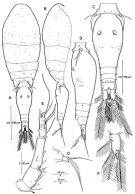 issued from : R. Böttger-Schnack in Mitt. hamb. zool. Mus. Inst., 1999, 96 [p.115, Fig.37]. Female ( from Red Sea): A, habitus (dorsal); B, idem (lateral right side); C, urosome (dorsal, seta on somite near P5 and right dorsal seta missing); D, idem (lateral right side); E, A1 (arrow indicating position of missing seta); F, caudal ramus (dorsal); G, P5 (dorsal, seta on somite missing). Nota: Proportional lengths (%) of urosomites and caudal rami 9.5:54.8:8.3:6.5:9.5:11.3.
Relative lengths (%) of segments of A1 measured along posterior non-setigerous margin 6.1:24.9:42.1:11.2:4.6:11.2. Anal somite slightly shorter than caudal rami. Caudal ramus about 2.0 times as long as wide.
|
 issued from : R. Böttger-Schnack in Mitt. hamb. zool. Mus. Inst., 1999, 96 [p.117, Fig.38]. Female : A, A2 (anterior, arrow indicating position of missing setules); B, labrum (anterior); C, idem ((posterior); D, Md (showing individual elements); E, Mx1; F, Mx2; G, Mxp (anterior) [g, basis and endopod, posterior].
|
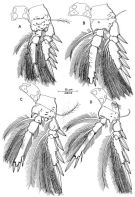 issued from : R. Böttger-Schnack in Mitt. hamb. zool. Mus. Inst., 1999, 96 [p.118, Fig.39]. Female: A, P1 (anterior); B, P2 (anterior); C, P3 (anterior); D, P4 (anterior).
|
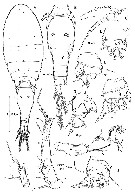 issued from : R. Böttger-Schnack in Mitt. hamb. Zool. Mus. Inst., 2004, 101. [p.217, Fig.1]. Female (from SE Hokkaido): A, habitus (dorsal, outer apical seta on left P5 and caudal setae V missing); B, urosome (dorsal, outer apical seta on right P5 and right seta on somite missing, right caudal ramus omitted, arrow indicating dislocated pore on genital double-somite); C, P5 (dorsal); D, P1 (coxa and basis, posterior, arrows indicating sexually dimorphic ornamentation) [exp = position of missing exopod, crosses indicating position of missing inner and outer basal seta]; E, P2 (coxa and basis, posterior, arrow indicating ornamentation[) exp = position of missing exopod; F, P3 (coxa and basis, posterior, arrow indicating ornamentation, crossindicating position of missing outer basal seta, missing seta on endop-1 stippled; G, P4 (coxa and basis, posterior, arrow indicating ornamentation). Male (from NW Pacific): H, A1 (crosses indicating elements missing on segment IV [h, segment IV, showing complete armament]); I, A2 (posterior, distal setae omitted, arrows indicating sexually dimorphic ornamentation characters); J, P1 (coxa slightly damaged and basis, posterior, showing sexual dimorphism in ornamentation , arrowed). Nota: Proportional lengths (%) of urosomites and caudal rami 10.2:53.3:8.2:7.4:40.7:11.5. Anal somite 1.4 times wider than long, about as long as caudal rami. Caudal ramus 1.9 times as long as wide.
|
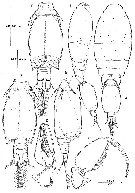 issued from : R. Böttger-Schnack in Mitt. hamb. Zool. Mus. Inst., 2004, 101. [p.219, Fig.2]. Male (from SE Hokkaido): A, habitus (dorsal, caudal setae IV + V missing, cross indicating position of missing seta III); B, idem (lateral right side, caudal seta III missing); C, Mxp (posterior); D, idem (medial view); E, urosome (dorsal, caudal seta III missing on both sides); F, idem (ventral, crosses indicating position of missing caudal seta III); G, idem (lateral right side, position of missing seta III indicated by insertion hole). Nota: Proportional lengths (%) of urosomites and caudal rami 11.2:57.1:3.7:3.5:3.3:10.0:11.2. Relative lengths (%) of segments of A1 measured along posterior non-setigerous margin 8.3:24.1:42.1:25.5. caudal rami 1.6 times longer than wide
|
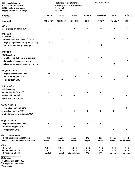 issued from : R. Böttger-Schnack in Mitt. hamb. Zool. Mus. Inst., 2004, 101. [p.220, Table 2]. Morphological characters separating males of the Triconia similis-subgroup and T. rufa ( conifera-subgroup).
| | | | | Compl. Ref.: | | | Nishibe & al., 2009 (p.491, Table 1: seasonal abundance) | | | | NZ: | 2 | | |
|
Distribution map of Triconia parasimilis by geographical zones
|
| | | | Loc: | | | S Red Sea: Strait of Bab al Mandab, Japan (Tosa Bay, SE Hokkaido: Oyashio region) | | | | N: | 3 | | | | Lg.: | | | (810) F: 0,75; (958) F: 0,71-0,74; M: 0,60; {F: 0,71-0,75; M: 0,60} | | | | Rem.: | epi-mesopelagic.
Close to Triconia similis with which this species can be confused.
May occur in the adjacent seas (eastern Mediterranean, Arabian Sea).
For Böttger-Schnack (1999, p.119) this species can be separated from T. similis by the length of the distal endopod segment in the A2; the form and surface ornamentation of the genital double-somite; the proportions of the postgenital segments; the length of terminal spine and the conical projection on P2 endopod; the length ratio of exopodal setae on P5; the length of the proximal seta on Mxp, and other minor differences. | | | Last update : 02/02/2016 | |
|
|
 Any use of this site for a publication will be mentioned with the following reference : Any use of this site for a publication will be mentioned with the following reference :
Razouls C., Desreumaux N., Kouwenberg J. and de Bovée F., 2005-2025. - Biodiversity of Marine Planktonic Copepods (morphology, geographical distribution and biological data). Sorbonne University, CNRS. Available at http://copepodes.obs-banyuls.fr/en [Accessed November 17, 2025] © copyright 2005-2025 Sorbonne University, CNRS
|
|
 |
 |









